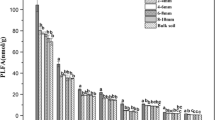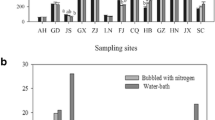Abstract
The objective of this study was to apply phospholipid fatty acid (PLFA)-based stable isotope probing to assess the temporal variation of active microorganisms associated with rhizosphere-C flow in a natural wetland. We applied 13CO2 pulse labeling at three different times throughout the vegetation period: spring (April), early summer (June), and early autumn (October). Soil redox potentials (Eh) at 10 cm depth ranged from moderately reduced (October) to oxidized conditions (June). Based on combined PLFA relative abundance and 13C enrichment results, we suggest that gram-negative bacteria play a main role in rhizodeposit-C uptake in these wetland ecosystems, especially when reduced soil conditions prevail in October. Arbuscular and saprotrophic fungi also take up a significant proportion of the belowground allocated C, though mostly in the summer period. Gram-positive bacteria showed only a minor reliance on rhizodeposit-C throughout the year. It is concluded that rhizodeposit-C-assimilating microbial communities are heterogeneous and temporal variable entities with groups that are capable of adapting differently to seasonally varying environmental conditions.



Similar content being viewed by others
References
Badri DV, Vivanco JM (2009) Regulation and function of root exudates. Plant Cell Environ 32:666–681. doi:10.1111/j.1365-3040.2009.01926.x
Balasooriya WK, Denef K, Peters J, Verhoest NEC, Boeckx P (2008) Vegetation composition and soil microbial community structural changes along a wetland hydrological gradient. Hydrol Earth Syst Sci 12:277–291
Beck-Nielsen D, Madsen TV (2001) Occurrence of vesicular–arbuscular mycorrhiza in aquatic macrophytes from lakes and streams. Aquat Bot 71:141–148
Bird JA, Herman DJ, Firestone MK (2011) Rhizosphere priming of soil organic matter by bacterial groups in a grassland soil. Soil Biol Biochem 43:718–725. doi:10.1016/j.soilbio.2010.08.010
Bohrer KE, Friese CF, Amon JP (2004) Seasonal dynamics of arbuscular mycorrhizal fungi in differing wetland habitats. Mycorrhiza 14:329–337. doi:10.1007/s00572-004-0292-7
Bossio DA, Fleck JA, Scow KM, Fujii R (2006) Alteration of soil microbial communities and water quality in restored wetlands. Soil Biol Biochem 38:1223–1233. doi:10.1016/j.soilbio.2005.09.027
Bossio DA, Scow KM (1995) Impact of carbon and flooding on the metabolic diversity of microbial communities in soils. Appl Environ Microbiol 61:4043–4050
Bowman JP, Sly LI, Stackebrandt E (1995) The phylogenetic position of the family Methylococcaceae. Int J Syst Bacteriol 45:182–185
Brimecombe MJ, De Leij F, Lynch JM (2001) Nematode community structure as a sensitive indicator of microbial perturbations induced by a genetically modified Pseudomonas fluorescens strain. Biol Fertil Soils 34:270–275
Broeckling CD, Broz AK, Bergelson J, Manter DK, Vivanco JM (2008) Root exudates regulate soil fungal community composition and diversity. Appl Environ Microbiol 74:738–744. doi:10.1128/aem.02188-07
Butler JL, Williams MA, Bottomley PJ, Myrold DD (2003) Microbial community dynamics associated with rhizosphere carbon flow. Appl Environ Microbiol 69:6793–6800. doi:10.1128/aem.69.11.6793-6800.2003
Cesco S, Mimmo T, Tonon G, Tomasi N, Pinton R, Terzano R, Neumann G, Weisskopf L, Renella G, Landi L, Nannipieri P (2012) Plant-borne flavonoids released into the rhizosphere: impact on soil bio-activities related to plant nutrition. A review. Biol Fertil Soils 48:123–149. doi:10.1007/s00374-011-0653-2
Crossman ZM, Ineson P, Evershed RP (2005) The use of 13C labelling of bacterial lipids in the characterisation of ambient methane-oxidising bacteria in soils. Org Geochem 36:769–778. doi:10.1016/j.orggeochem.2004.12.005
Denef K, Bubenheim H, Lenhart K, Vermeulen J, Van Cleemput O, Boeckx P, Muller C (2007) Community shifts and carbon translocation within metabolically-active rhizosphere microorganisms in grasslands under elevated CO2. Biogeosciences 4:769–779. doi:10.5194/bgd-4-1437-2007
Denef K, Roobroeck D, Manimel Wadu MCW, Lootens P, Boeckx P (2009) Microbial community composition and rhizodeposit-carbon assimilation in differently managed temperate grassland soils. Soil Biol Biochem 41:144–153. doi:10.1016/j.soilbio.2008.10.008
Dighton J (2003) Fungi in ecosystem processes. Marcel Dekker, New York
Dixon P (2003) VEGAN, a package of R functions for community ecology. J Veg Sci 14:927–930
Drigo B, Pijl AS, Duyts H, Kielak A, Gamper HA, Houtekamer MJ, Boschker HTS, Bodelier PLE, Whiteley AS, van Veen JA, Kowalchuk GA (2010) Shifting carbon flow from roots into associated microbial communities in response to elevated atmospheric CO2. Proc Natl Acad Sci USA 107:10938–10942. doi:10.1073/pnas.0912421107
Federle TW, Dobbins DC, Thorntonmanning JR, Jones DD (1986) Microbial biomass, activity, and community structure in subsurface soils. Ground Water 24:365–374
Fourcans A, Ranchou-Peyruse A, Caumette P, Duran R (2008) Molecular analysis of the spatio-temporal distribution of sulfate-reducing bacteria (SRB) in Camargue (France) hypersaline microbial mat. Microb Ecol 56:90–100. doi:10.1007/s00248-007-9327-x
Frostegård A, Bååth E (1996) The use of phospholipid fatty acid analysis to estimate bacterial and fungal biomass in soil. Biol Fertil Soils 22:59–65. doi:10.1007/BF00384433
Frund C, Cohen Y (1992) Diurnal cycles of sulfate reduction under oxic conditions in cyanobacterial mats. Appl Environ Microbiol 58:70–77
Gamper H, Hartwig UA, Leuchtmann A (2005) Mycorrhizas improve nitrogen nutrition of Trifolium repens after 8 yr of selection under elevated atmospheric CO2 partial pressure. New Phytol 167:531–542. doi:10.1111/j.1469-8137.2005.01440.x
Gee GW, Bauder JW (1986) Particle-size analysis. In: Klute A (ed) Methods of soil analysis, part 1. Physical and mineralogical methods, 2nd edn. American Society of Agronomy, Soil Science Society of America, Madison, pp 383–411
Grayston SJ, Griffith GS, Mawdsley JL, Campbell CD, Bardgett RD (2001) Accounting for variability in soil microbial communities of temperate upland grassland ecosystems. Soil Biol Biochem 33:533–551. doi:10.1016/S0038-0717(00)00194-2
Gutknecht JLM, Goodman RM, Balser TC (2006) Linking soil process and microbial ecology in freshwater wetland ecosystems. Plant Soil 289:17–34. doi:10.1007/s11104-006-9105-4
Hedrick DB, Peacock AD, Lovley DR, Woodard TL, Nevin KP, Long PE, White DC (2009) Polar lipid fatty acids, LPS-hydroxy fatty acids, and respiratory quinones of three Geobacter strains, and variation with electron acceptor. J Ind Microbiol Biotechnol 36:205–209. doi:10.1007/s10295-008-0486-7
Howarth RW, Teal JM (1979) Sulfate reduction in a New England salt marsh. Limnol Oceanogr 24:999–1013
Jin G, Kelley TR (2007) Characterization of microbial communities in a pilot-scale constructed wetland using PLFA and PCR–DGGE analyses. J Environ Sci Health Part A-Toxic/Hazard Subst Environ Eng 42:1639–1647. doi:10.1080/10934520701518125
Joergensen RG, Emmerling C (2006) Methods for evaluating human impact on soil microorganisms based on their activity, biomass, and diversity in agricultural soils. J Plant Nutr Soil Sci 169:295–309. doi:10.1002/jpln.200521941
Joergensen RG, Wichern F (2008) Quantitative assessment of the fungal contribution to microbial tissue in soil. Soil Biol Biochem 40:2977–2991
Klironomos JN (2003) Variation in plant response to native and exotic arbuscular mycorrhizal fungi. Ecology 84:2292–2301
Kreuzer-Martin HW (2007) Stable isotope probing: linking functional activity to specific members of microbial communities. Soil Sci Soc Am J 71:611–619. doi:10.2136/sssaj2006.0093
Kuzyakov Y (2002) Review: factors affecting rhizopshere priming effects. J Plant Nutr Soil Sci 165:382–396
Londry KL, Jahnke LL, Marais DJD (2004) Stable carbon isotope ratios of lipid biomarkers of sulfate-reducing bacteria. Appl Environ Microbiol 70:745–751. doi:10.1128/aem.70.2.745-751.2004
Lu YH, Abraham WR, Conrad R (2007) Spatial variation of active microbiota in the rice rhizosphere revealed by in situ stable isotope probing of phospholipid fatty acids. Environ Microbiol 9:474–481. doi:10.1111/j.1462-2920.2006.01164.x
Lynch JM, Whipps JM (1990) Substrate flow in the rhizosphere. Plant Soil 129:1–10
Mansfeldt T (2003) In situ long-term redox potential measurements in a dyked marsh soil. J Plant Nutr Soil Sci 166:210–219
McKinley VL, Peacock AD, White DC (2005) Microbial community PLFA and PHB responses to ecosystem restoration in tallgrass prairie soils. Soil Biol Biochem 37:1946–1958. doi:10.1016/j.soilbio.2005.02.033
Mentzer JL, Goodman RM, Balser TC (2006) Microbial response over time to hydrologic and fertilization treatments in a simulated wet prairie. Plant Soil 284:85–100. doi:10.1007/s11104-006-0032-1
Miller RM, Smith CJ, Jastrow JD, Bever JD (1999) Mycorrhizal status of the genus Carex (Cyperaceae). Am J Bot 86:547–553
Neubauer SC, Givler K, Valentine SK, Megonigal JP (2005) Seasonal patterns and plant-mediated controls of subsurface wetland biogeochemistry. Ecology 86:3334–3344
Neufeld JD, Vohra J, Dumont MG, Lueders T, Manefield M, Friedrich MW, Murrell JC (2007) DNA stable-isotope probing. Nature Protoc 2:860–866. doi:10.1038/nprot.2007.109
Olsson PA (1999) Signature fatty acids provide tools for determination of the distribution and interactions of mycorrhizal fungi in soil. FEMS Microb Ecol 29:303–310
Olsson PA, Johnson NC (2005) Tracking carbon from the atmosphere to the rhizosphere. Ecol Lett 8:1264–1270. doi:10.1111/j.1461-0248.2005.00831.x
Paterson E, Gebbing T, Abel C, Sim A, Telfer G (2007) Rhizodeposition shapes rhizosphere microbial community structure in organic soil. New Phytol 173:600–610
Paul EA (2007) Soil microbiology, ecology and biochemistry, 3rd edn. Academic, Amsterdam
Peters J, Samson R, Boeckx P, Balasooriya WK, Verhoest NEC (2009) Hydrological and vegetation analysis of an alluvial floodplain in Belgium. Belg J Bot 142:19–38
Potthoff M, Steenwerth KL, Jackson LE, Drenovsky RE, Scow KM, Joergensen RG (2006) Soil microbial community composition as affected by restoration practices in California grassland. Soil Biol Biochem 38:1851–1860. doi:10.1016/j.soilbio.2005.12.009
Qiu QF, Noll M, Abraham WR, Lu YH, Conrad R (2008) Applying stable isotope probing of phospholipid fatty acids and rRNA in a Chinese rice field to study activity and composition of the methanotrophic bacterial communities in situ. ISME J 2:602–614. doi:10.1038/ismej.2008.34
R Development Core Team (2009) R: a language and environment for statistical computing. R Foundation for Statistical Computing, Vienna
Radajewski S, Ineson P, Parekh NR, Murrell JC (2000) Stable-isotope probing as a tool in microbial ecology. Nature 403:646–649
Reddy K, DeLaune RD (2008) Biogeochemistry of wetlands: science and applications. CRC, Boca Raton
Schamin’ee JHJ, Stortelder AHF, Westhoff V (1995) De vegetatie van Nederland: Deel 2: Plantengemeenschappen van wateren, moerassen en natte heiden. Opulus, Uppsala
Sørensen J (1997) The rhizosphere as a habitat for soil microorganisms. In: van Elsas JD, Trevors JT, Wellington AMK (eds) Modern soil microbiology. Marcel Dekker, New York, pp 21–45
Steer J, Harris JA (2000) Shifts in the microbial community in rhizosphere and non-rhizoshere soils during the growth of Agrostis stolobifera. Soil Biol Biochem 32:869–878
Sundh I, Nilsson M, Borga P (1997) Variation in microbial community structure in two boreal peatlands as determined by analysis of phospholipid fatty acid profiles. Appl Environ Microbiol 63:1476–1482
Taylor J, Parkes RJ (1983) The cellular fatty acids of the sulphate-reducing bacteria, Desulfobacter sp., Desulfobulbus sp. and Desulfovibrio desulfuricans. J Gen Microbiol 129:3303–3309
Teske A, Ramsing NB, Habicht K, Fukui M, Kuver J, Jorgensen BB, Cohen Y (1998) Sulfate-reducing bacteria and their activities in cyanobacterial mats of Solar Lake (Sinai, Egypt). Appl Environ Microbiol 64:2943–2951
Van der Krift TAJ, Kuikman PJ, Moller F, Berendse F (2001) Plant species and nutritional-mediated control over rhizodeposition and root decomposition. Plant Soil 228:191–200
Venkateswaran K, Moser DP, Dollhopf ME, Lies DP, Saffarini DA, MacGregor BJ, Ringelberg DB, White DC, Nishijima M, Sano H, Burghardt J, Stackebrandt E, Nealson KH (1999) Polyphasic taxonomy of the genus Shewanella and description of Shewanella oneidensis sp. nov. Int J Syst Bacteriol 49:705–724
Waldrop MP, Firestone MK (2004) Microbial community utilization of recalcitrant and simple carbon compounds: impact of oak-woodland plant communities. Oecologia 138:275–284. doi:10.1007/s00442-003-1419-9
Walkley A, Black IA (1934) An examination of Degtjareff method for determining soil organic matter, and a proposed modification of the chromic acid titration method. Soil Sci 37:29–38
Welsh AK, Burke DJ, Hamerlynck EP, Hahn D (2010) Seasonal analyses of arbuscular mycorrhizae, nitrogen-fixing bacteria and growth performance of the salt marsh grass Spartina patens. Plant Soil 330:251–266. doi:10.1007/s11104-009-0197-5
Wilkinson SG (1988) Gram-negative bacteria. In: Ratledge C, Wilkinson SG (eds) Microbial lipids. Academic, London, pp 299–488
Zelles L (1997) Phospholipid fatty acid profiles in selected members of soil microbial communities. Chemosphere 35:275–294
Zelles L (1999) Fatty acid patterns of phospholipids and lipopolysaccharides in the characterisation of microbial communities in soil: a review. Biol Fertil Soils 29:111–129
Zhang CLL, Li YL, Ye Q, Fong J, Peacock AD, Blunt E, Fang JS, Lovley DR, White DC (2003) Carbon isotope signatures of fatty acids in Geobacter metallireducens and Shewanella algae. Chem Geol 195:17–28. doi:10.1016/s0009-2541(02)00386-8
Acknowledgments
This study was funded by the special research fund (BOF) of the Ghent University. Dries Huygens is a postdoctoral fellow of the Fund for Scientific Research—Flanders (FWO).
Author information
Authors and Affiliations
Corresponding author
Electronic supplementary material
Below is the link to the electronic supplementary material.
ESM 1
(PDF 307 kb)
Rights and permissions
About this article
Cite this article
Balasooriya, W.K., Huygens, D., Denef, K. et al. Temporal variation of rhizodeposit-C assimilating microbial communities in a natural wetland. Biol Fertil Soils 49, 333–341 (2013). https://doi.org/10.1007/s00374-012-0729-7
Received:
Revised:
Accepted:
Published:
Issue Date:
DOI: https://doi.org/10.1007/s00374-012-0729-7




